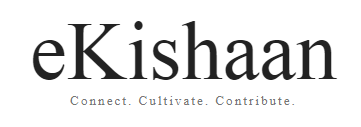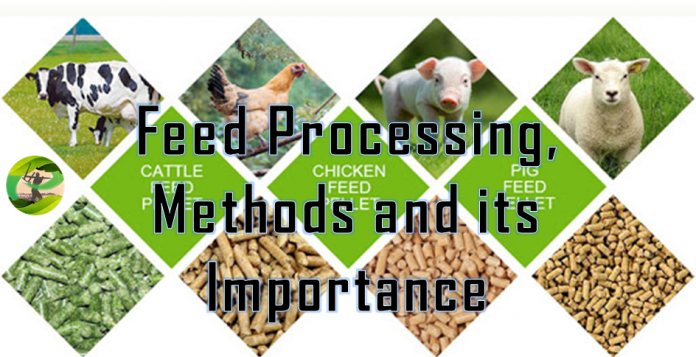Feed Processing and its importance
Modification in terms of physical, chemical properties of feed that leads to ease and efficient feeding behavior of animal is called feed processing. Feeds are important and most deciding factor in animal production. In ruminants, the feeds represent 50% or more of the total production costs and in non-ruminants, the feed cost may be 80% or more of total production. Feed processing not only enhance the feed quality; it also minimizes the loss during feeding. Feed preparatory methods that are used for swine and poultry are relatively simple and few as compared to the variety of methods available for ruminant feeds. Different kinds of treatments like washing, water soaking, reconstitution, grinding, drying, heat treatment, rolling, fermentation applied for nutritional improvement and / or storage life are known as feed processing methods. These methods may be physical, chemical, and microbiological.
Common goals of feed processing:
- Improved feed conversion or efficiency.
- Increased feed intake and faster average daily gain.
- Improved carcass quality and/or yield grade.
- Reduction in feed waste.
- Lower transportation and storage costs.
- Reduced labor costs due to increased mechanization.
- Reduced energy costs of processing (drying versus ensiling).
- Reduced harvest costs (i.e. high moisture corn).
- Improved cattle health by reduction in digestive disorders (founder, bloat & acidosis).
Methods of feed processing:
Feed processing methods are divided into dry and wet processes or into cold and hot processing.
-
Dry processing methods:
1. Decortications/de-hulling: Removing the cover or outer parts of seed, stem, fruits is called de-hulling. De-hulling of feed ingredients will yield a meal with higher crude protein, available lysine and lower crude fiber.
2.Popping and Micronizing: Popping is done by the action of dry heat, which causes a sudden expansion that ruptures the endosperm of the seed. Hot air is passed for 30 seconds followed by rolling which increase rumen and intestinal starch utilization but results in a low density feed. Consequently, feeds usually rolled before feeding to reduce bulk. Micronizing essentially the same as popping, except that is provided in the form of infrared energy. In micronizing process infrared heat is passed for 3 minutes followed by rolling.
3.Pelleting: Pelleting is the process to compress small particles into large solid with a given shape and texture which involves the combination of moisture, heat and pressure. It Increases palatability of feed, alleviates separation of ingredients and sorting (protein concentrates- reduces loss even when fed on ground or windy areas). Increases feed density. Reduce storage space, transportation costs too.
4.Grinding: It is the process of cutting grains into smaller particles by means of hand stone, hammer mills, roller mills.
5.Roasting: Roasting is the process of running grain through an open flame at a specific temperature for certain amount of time which kills spores, mould in feed and increase digestibility.
6.Crimping: Rolling of feeds with the use of corrugated rollers.
7.Cracking/Dry rolling: Disintegration of kernels into particles with the application of pressure by moving rollers.
2. Wet processing method:
1.Steam rolling: Treatment of grains with hot team for short period of 3-5 minutes in the tower followed by rolling.
2.Water soaking: Grains are soaked for 12-24 hours. Grains enlarge due to absorption of water and became soft.
3.Steam flaking: Grains are subjected to high moisture steam for a sufficient time to raise the water content to 18-20%. After rolling of such grains, flakes are produced.
4.Extrusion: Extrusion is the process in which grain are passed through a machine, ground and heated and mixed other ingredient producing ribbon- like product. Gelatinization of starch improves the digestibility of feed.
5.Gelatinization of starch: The complete disintegration of starch or compounded feed brought about by the application of moisture, heat and pressure.
Pressure cooking and flaking: Grains are cooked under steam pressure, cooled to room temperature and then rolled.
6.Reconstitution: Adding enough water to dry grains 10-13% to raise its moisture content to 25-30% and stored in anaerobic condition for 21 days. Grain produces amylases and proteases which solublize the starch.
Advantage of feed processing:
- There is a nutritional improvement by removing or inactivating the anti- nutritional factors present that interfere in nutrient utilization and hazardous for the health and production of the animals.
- There is improvement in keeping quality of feed ingredients.
- Feeds become free from the pathogenic organisms like bacteria, fungi, and parasites.
- Increase the acceptance and digestibility of feed results improved performance.
- Starch gelatinization takes place.
- Protein are denatured, escape, from rumen and digested in intestine.
- Increases palatability
- Reduce transportation cost.
Conclusion:
The commonly used feed processing methods like pelleting, popping, crumbing, grinding, steam flaking, extrusion, and expansion combined with steam conditioning affect the performance in different ways. High feed density through compaction enables an increase of feed intake and reduced the time spent feeding, subsequently improving growth rate and feed to weight gain ratio. Pelleted and extruded feed have further advantages through reducing dust, avoidance of particle separation during transport, selective feed intake and reduced feed waste. The effect of feed treatment on the availability of nutrients, feed additive sand hygienic status depends on a multitude of factors: level of pressure, temperature and moisture, du-ration of conditioning, type, particle size and thermo-ability of the raw components. Appropriate application of the procedure improves the digestibility of the main nutrients and reduces potentially harmful micro-organisms.

